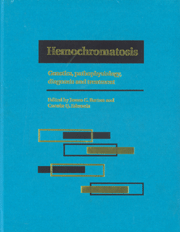Book contents
- Frontmatter
- Contents
- List of contributors
- Foreword
- Part I Introduction to hemochromatosis
- Part II Genetics of hemochromatosis
- Part III Metal absorption and metabolism in hemochromatosis
- 10 Intestinal iron-binding proteins
- 11 Intestinal iron absorption and hemochromatosis
- 12 The absorption and metabolism of non-ferrous metals in hemochromatosis
- 13 Ferritin metabolism in hemochromatosis
- 14 Hepatic iron metabolism in hemochromatosis
- 15 Extra-hepatic iron metabolism in hemochromatosis
- 16 Mathematical models of metal metabolism in hemochromatosis
- 17 Expression of iron overload in hemochromatosis
- Part IV Diagnostic techniques for iron overload
- Part V Complications of iron overload
- Part VI Therapy of hemochromatosis and iron overload
- Part VII Infections and immunity in hemochromatosis
- Part VIII Hemochromatosis heterozygotes
- Part IX Relationship of hemochromatosis to other disorders
- Part X Animal models of hemochromatosis and iron overload
- Part XI Screening for hemochromatosis
- Part XII Hemochromatosis: societal and ethical issues
- Part XIII Final issues
- Index
10 - Intestinal iron-binding proteins
from Part III - Metal absorption and metabolism in hemochromatosis
Published online by Cambridge University Press: 05 August 2011
- Frontmatter
- Contents
- List of contributors
- Foreword
- Part I Introduction to hemochromatosis
- Part II Genetics of hemochromatosis
- Part III Metal absorption and metabolism in hemochromatosis
- 10 Intestinal iron-binding proteins
- 11 Intestinal iron absorption and hemochromatosis
- 12 The absorption and metabolism of non-ferrous metals in hemochromatosis
- 13 Ferritin metabolism in hemochromatosis
- 14 Hepatic iron metabolism in hemochromatosis
- 15 Extra-hepatic iron metabolism in hemochromatosis
- 16 Mathematical models of metal metabolism in hemochromatosis
- 17 Expression of iron overload in hemochromatosis
- Part IV Diagnostic techniques for iron overload
- Part V Complications of iron overload
- Part VI Therapy of hemochromatosis and iron overload
- Part VII Infections and immunity in hemochromatosis
- Part VIII Hemochromatosis heterozygotes
- Part IX Relationship of hemochromatosis to other disorders
- Part X Animal models of hemochromatosis and iron overload
- Part XI Screening for hemochromatosis
- Part XII Hemochromatosis: societal and ethical issues
- Part XIII Final issues
- Index
Summary
Introduction
The major disturbance in hemochromatosis is the excessive lifelong absorption of dietary iron that eventually results in excessive body iron loading. Under normal circumstances, iron absorption is carefully controlled according to the body iron stores. This control is disturbed in hemochromatosis and enhanced iron absorption continues despite the presence of expanded body iron stores.
The regulation of iron status is normally carried out at the level of the enterocyte in the upper small bowel. Intrinsic regulation factors are undoubtedly present within the mucosal cell itself, and internal body regulatory factors are also at play, relaying body iron needs according to the whole body iron status. Until recently, there was no animal model of hemochromatosis, and in vivo studies of iron metabolism in humans were limited by the difficulty of obtaining direct access to small bowel mucosal cells. Significant progress has recently been made in these areas. The proteins involved in the different phases of non-heme and heme iron absorption at the level of the gastrointestinal tract are discussed below, emphasizing known abnormalities in hemochromatosis.
Phases of absorption
Iron absorption consists of a series of mechanistically distinct, temporarily synchronous, overlapping stages. These consists of iron presentation to cells and uptake by the mucosal cells, transcellular transport and handling of iron, and finally the transfer of iron out of the mucosal cell into the portal venous system. The various proteins presumed to be involved in the different phases of absorption are depicted in Table 10.1.
- Type
- Chapter
- Information
- HemochromatosisGenetics, Pathophysiology, Diagnosis and Treatment, pp. 107 - 117Publisher: Cambridge University PressPrint publication year: 2000
- 1
- Cited by



